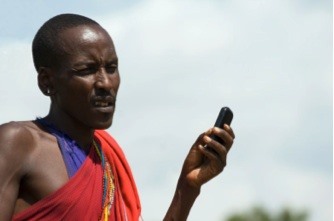 People living in sub-Saharan Africa still don’t have the same amount of high-speed Internet access that people in other parts of the world do. Fixed broadband penetration in sub-Saharan Africa is about one percent, compared with about 27.2 percent in developed nations.
People living in sub-Saharan Africa still don’t have the same amount of high-speed Internet access that people in other parts of the world do. Fixed broadband penetration in sub-Saharan Africa is about one percent, compared with about 27.2 percent in developed nations.
But when it comes to mobile technology, Africa keeps up nicely with other continents — the International Telecommunication Union reports an average of 63.5 mobile Internet subscriptions per 100 residents in sub-Saharan countries. That’s not too bad, compared to rates of 88.7 per 100 residents in Asia, 126.5 in Europe and 109.4 in the Americas. A new streaming service, Tuluntulu, aims to bring video streaming to the furthest-flung corners of this massive continent, by allowing users to stream videos at speeds of 30 to 300kbps.
Use of Mobile Technology Growing Fast in Africa
Most people in Africa lack access to a fixed broadband connection, so they access the Internet not through a computer, but through a mobile device. Mobile-broadband penetration is expanding rapidly in Africa — between 2010 and 2013, it shot up from two to 11 percent.
However, connection speeds are low; they hover somewhere around 50kbps, and often much lower. At those speeds, it’s impossible to stream videos using the same services popular in areas like Europe, where fixed broadband penetration is high. YouTube is able to offer adaptive streaming at 75kbps to users in low-broadband areas, but that’s still more Internet than many African mobile users can manage to get, especially since mobile connection speeds tend to vary widely from one moment to the next.
 Super-Low-Broadband Streaming with Tuluntulu
Super-Low-Broadband Streaming with Tuluntulu
A Technology Innovation Agency-funded South African consortium consisting of the University of Cape Town, East Coast Access and the Council for Scientific and Industrial Research has produced a mobile streaming platform that allows users in remote, low-broadband areas to stream watchable videos at speeds as low as 24kbps. The platform, called Tuluntulu after the Zulu word for stream, allows African users to stream video content on GSM/EDGE networks using algorithms that adjust video quality to match the available bandwidth from one second to the next. Tuluntulu uses Adaptive Real-Time Internet Streaming Technology, or ARTIST, to accomplish this feat. In addition to streaming videos, users can also access social media websites and other online services using Tuluntulu.
Pierre van der Hoven, the platform’s main financial supporter, believes the product is superior to any other platform for low-bandwidth streaming. “The ARTIST technology can deliver unbroken video at ±30kbps. Current competing technologies do not perform well in low rate Internet infrastructures between 30kbps and 300kbps, and, more particularly, where the throughput rate is rapidly varying within this range from one second to the next — as is common in all mobile cellular networks,” he told VentureBurn.
The platform, which is still in beta, can be downloaded from the Google Play Store onto any Android device running version 4.0 or later. Two radio stations, the Voice of Wits and YFM, have successfully used the ARTIST technology to broadcast to listeners over mobile devices.
Broadband users in remote areas, notably sub-Saharan Africa, will soon have increased access to streaming video thanks to a new low-broadband platform called Tuluntulu. The platform, which is available for Android, capitalizes on the rapid growth of mobile in the developing world to improve the online experience within the confines of the infrastructure they already have.